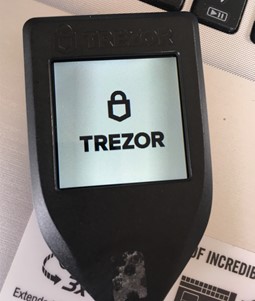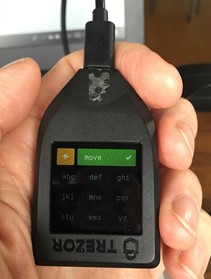The New TREZOR Model-T: The Better Way to Be Your Own Bank
 One of the best things about bitcoin is that you can be your own bank. No longer do you have to go through those middlemen, wondering what they are tracking, wondering what they are telling the government or other organizations about
One of the best things about bitcoin is that you can be your own bank. No longer do you have to go through those middlemen, wondering what they are tracking, wondering what they are telling the government or other organizations about
you, wondering when they will limit or freeze your accounts. With bitcoin, you can send any amount, to anyone, anywhere in the world. This creates the possibility of creating a worldwide cash economy that is self, rather than government, regulated.
One of the worst things about bitcoin is that you have to be your own bank. You personally have to store and secure your coins. If anything happens – hacks, forgotten passwords, file corruption – there is no one to call to regain access, no one to call to refund your money. In the short history of cryptocurrencies, the number of hacked and lost coins is estimated to be in the millions, which underscores just how serious a problem this is.
Some would tell you that this is a reason to steer clear of cryptocurrencies – they are just too risky. Not true. Like any new technology, when it is brand new, there are always problems, and it is the early users who find and call out the need to fixes of those problems so that the people who come later will have a smoother, safer experience.
 One of the earliest serious hacks of bitcoin came in 2012 when a hacker was able to get into a cloud service provider’s infrastructure and make away with the contents of a bitcoin wallet – netting a nice 3094 bitcoin haul. At the time, the technology was new enough and the value was low enough that people hadn’t yet given that much thought to how to really secure their digital assets yet. The owner of the wallet, Marek Palatinus, took this event as a wake-up call. He understood that as the value of bitcoin rose, people’s bitcoin holdings would increasingly become attractive targets for hackers.
One of the earliest serious hacks of bitcoin came in 2012 when a hacker was able to get into a cloud service provider’s infrastructure and make away with the contents of a bitcoin wallet – netting a nice 3094 bitcoin haul. At the time, the technology was new enough and the value was low enough that people hadn’t yet given that much thought to how to really secure their digital assets yet. The owner of the wallet, Marek Palatinus, took this event as a wake-up call. He understood that as the value of bitcoin rose, people’s bitcoin holdings would increasingly become attractive targets for hackers.
Palatinus created Trezor, the first cryptocurrency hardware wallet. His key insight was that in order to steal people’s bitcoin’s, hackers needed to get the coins’ private keys. His had been stored on the cloud and had been exposed. He also realized that keeping them on any internet-connected device was going to be risky. So Palatinus developed a device that could store the keys and authorize transactions, but which would never let the keys be accessible to any internet connected machine.
Soon after, Trezors were made available for sale and gained the trust of many of the biggest names in the community as a great and convenient way to keep their bitcoins safe.
SatoshiLabs, the company that makes Trezor, provided us with a Model T. Here’s what we found:
The Basics:
In the box, you get a small plastic device about the size of a key fob. Though plastic, because of its size and weight, it feels solid and durable, though I wouldn’t want to test that by dropping it a lot. It also comes with a micro USB cable to connect it to your computer. The device has no power source of its own and will turn on when connected.
 The new Trezor has two physical improvements over the older model: a USB-C connector and a touch screen. The USB-C is great as it can be inserted either way, meaning you don’t have to fiddle with it wonder which way is up. The touch screen is also great as it makes navigating the setup procedure and the authorization of transactions much easier.
The new Trezor has two physical improvements over the older model: a USB-C connector and a touch screen. The USB-C is great as it can be inserted either way, meaning you don’t have to fiddle with it wonder which way is up. The touch screen is also great as it makes navigating the setup procedure and the authorization of transactions much easier.
Interestingly, the new model also came with a magnetic plate that will stick to the back of the Trezor. If you use your Trezor a lot and want to keep it within arm’s reach, you can peel off the film on the back of the plate and put it somewhere convenient. When not in use, the Trezor will be magnetically secured. Or, alternatively, you can find some hidden nook with some pipes and keep the Trezor out of sight.
The Set Up:
Once you connect the device to your computer and go to the website,
trezor.io/start, which will prompt you to install the Trezor Bridge connection software on your computer. The site will also download and install the latest firmware for the device.

I can’t speak highly enough of the fact that the Trezor doesn’t come preinstalled with its software. This ensures that no one has intercepted the device in transit and tampered with its programming. It also has tamper resistant tape which leaves horrible residue on the device when you peal it off. The residue will come off with a bit of water and elbow grease – but it would be near-impossible for someone to remove and reseal the device with the tape if they wanted to tamper with the internal workings.
After installing the firmware, the website will then walk you through the set up procedure, which will include writing down a list of 12 words you will need to recover your coins if anything happens to your Trezor and a PIN to ensure that only you can authorize transactions.
Using the Trezor:
Once the Trezor is activated, you can access your wallet at trezor.io/start. You can create addresses to have coins sent to, send coins, and track all your transactions. You can also create wallets for 8 other cryptocurrencies, including Ether, Litecoin, and Bitcoin Cash.
For me, I have never really liked using wallets online, though. If something were to happen to the website, I would have my keys, but I might have no way to move my coins. Fortunately, Trezor works with the popular bitcoin wallet Electrum. Once you set up the Electrum with your Trezor, it will act essentially as a ‘watch only’ wallet – allowing you to track bitcoins being sent to you, modify descriptions of transactions, and create receiving addresses. If you want to send bitcoins, then Electrum will ask you to connect your Trezor to authorize the transaction by inputting your PIN.
Is it worth it?
 In a word, yes. I’ve been in bitcoin since early 2013. I’ve used online wallets, cold storage, and paper wallets. I’ve also lost what to me is a significant amount of bitcoins in the CoinLenders Hack and a small number in the MTGox debacle. Over time, and with the rise in value of cryptocurrencies, I have become very sensitive to security – and having a Trezor is a great relief. It allows me to feel my coins are well-secured, but is also convenient and easy for when I want to get at my stash.
In a word, yes. I’ve been in bitcoin since early 2013. I’ve used online wallets, cold storage, and paper wallets. I’ve also lost what to me is a significant amount of bitcoins in the CoinLenders Hack and a small number in the MTGox debacle. Over time, and with the rise in value of cryptocurrencies, I have become very sensitive to security – and having a Trezor is a great relief. It allows me to feel my coins are well-secured, but is also convenient and easy for when I want to get at my stash.
If you have any significant amount of bitcoin, ether, or other supported currency, I would highly recommend you take a look at what the Trezor Model T has to offer here.



